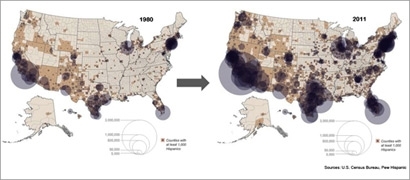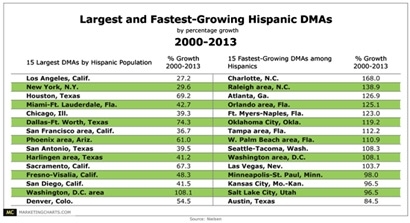I often say the Hispanic market in the U.S. has been changing as quickly as it has been growing the last 15 years. One of the biggest ways it has changed
is geographic distribution. One only has to take a quick glimpse at the following heat map to understand how the Hispanic population is spreading to what demographers increasingly refer to as
“nontraditional” Hispanic markets (see map below).
Nielsen reported in May 2013 the Hispanic population has at least doubled in 11 nontraditional markets, led by Charlotte,
N.C., since 2000. While traditional Hispanic population centers like Los Angeles and Miami have continued to see double-digit Hispanic population growth, they are growing at a much slower pace (see
chart below).
As I discussed in a previous article, Hispanics are
increasingly immigrating to nontraditional markets outside the Hispanic immigrant gateways of Los Angeles, New York, Miami and Chicago. Mexicans have been migrating to nontraditional states in the
Southeast and Midwest — Georgia, North Carolina, Ohio, Wisconsin, Nebraska, etc. — and less to traditional areas in the border states and the Southwest.
advertisement
advertisement
The Nielsen report indicates some of these markets may become the next Hispanic population centers, appearing on top 10 Hispanic market lists alongside
mainstays like L.A. and New York. What will these new Hispanic markets in the South, Midwest, and northern plains look like over the next five to 10 years? They will likely share similar growth
patterns to major Hispanic markets in the 1980s, seeing sustained Hispanic population growth driven by a healthy mix of net new Hispanic immigration coupled with high birthrates. Like traditional
Hispanic markets in the 1980s, many of these nontraditional markets, like Charlotte and Oklahoma City, are seeing significant job creation and overall population growth. This will have a strong
“pull” effect on net Hispanic immigration, primarily from Mexico and Central America.
However, today’s digital world
presents a very different media reality for Hispanics making their way in these nontraditional markets. While markets like Atlanta and Kansas City, Mo., do not have anywhere near the Spanish-language
media options that exist in markets like New York or Miami, they have new, low-cost and highly mobile digital media options their Hispanic immigrant predecessors did not have in Dallas or Phoenix in
the 1980s. They will be able to listen to whatever music, view whatever programming, and read content from home online, via their mobile devices. They will also be able to stay connected to each other
and their home countries via social media options.
I believe the emergence of these nontraditional Hispanic markets will shake up
Hispanic marketing in two fundamental ways beyond changing the list of top 15 Hispanic markets:
1. The end of the 7-Market Hispanic Marketing
Model – It’s a common practice among marketers to approach Hispanic marketing programs by focusing on a small number of markets, namely Los Angeles, New York, Miami, Chicago, Dallas, San
Francisco, and Phoenix. However, this model will become increasingly flawed, as too much of the Hispanic market will be “left on the table.”
2. Emergence of two distinct Hispanic markets – The emergence of new Hispanic markets will coincide with the evolution of the largest Hispanic markets into “new
mainstream” or fusion markets. This will result in two very different types of Hispanic markets in the U.S.: new “minority” immigrant-driven Hispanic population centers in places
like Washington, D.C., and Raleigh-Durham, N.C., and native-born Hispanic majority markets where a new fusion culture is taking place

